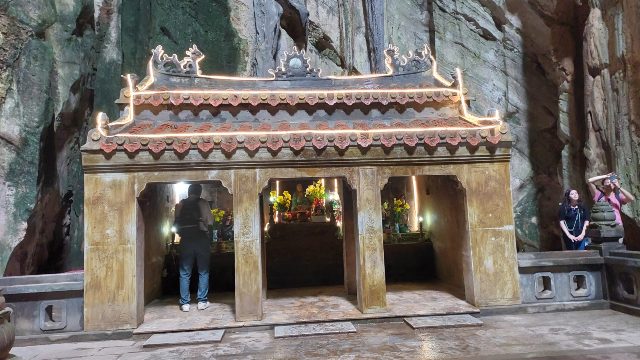Turning to a passage on the right side from Hoa Nghiem cave leads to a huge cave, the Huyen Khong Cave. It is one of the largest cave on the top of Thuong Thai mountains.
The cave during the war, served as a base for the Vietnamese army to plan strategies, train soldiers and also served as a hospital to treat injured soldiers. The sheer size of the cave makes you gasp. It is massive.
passage leading to Huyen Khong cave from Hoa Nghiem cave
Past of Huyen Khong cave:
Being in a remote location, this cave has witnessed many transformations over a period of years. It functioned as an army station many times. During the French Colonial War, it served as a base for the local revolutionaries. Then, during the Second Indochina War, it was a military training ground for the American and South Vietnamese forces.
In 1968, the Viet Minh used the location as a medical unit for liberation army.
view of the cave
With the cave circumference of 25 meters, it has small shrines inside its fold. The natural lights entering the cave through holes on the ceiling are enough, spotlights have been added at places for visitors to get a better view.
Temple guardians during the Champa period on both sides of stairway have now been painted in bright colors. Similar guardians can be seen outside Tam Thanh cave in Tang Chon Cave. They used to guard the Cham temple earlier.
These guardians have been repainted in bright colors, and am sure the new look is very different from the original statues. The ones in left were said to be administrative mandarins and ones to right as military mandarins.
entering cave from Hoa Nghiem
Military mandarins in blue with sword in their hands, seated on a lion at the entrance on the right side
Administrative mandarins in red with sword sit on the left side of stairs.
The first thing one notices immediately after entering the cave is a 3 meter high Sakyamuni Buddha--- Phật Thích Ca in the center of cave. He is seated a little above the floor.
The image in marble was sculpted by Nguyen Chat in 1960. There are many
skilled sculptors in Non Nuoc stone carving village at the base of
mountain selling plenty of things. It is a good idea to explore the shops and take back home some souvenirs.Below Gautam Buddha, is the altar of Dia Tang Vuong Bo Tat (Khsitigarbha). He is one of the four principal Bodhisattva and is the most powerful Buddha of hell.
praying to Sakhyamuni Buddha
the vastness of the cave can be imagined by this
Openings in the roof of cave lets in sunlight inside. This lends a spectacular aura to the cave.
Like Linh Nham pagoda, this cave also has no limestone karts hanging from its ceiling.
Like Linh Nham pagoda, this cave also has no limestone karts hanging from its ceiling.
Shrines in the cave:
Shrines of 'Ngoc Phi' and 'Loi Phi'
Ba Chua Tien Temple:
On
the left side of the cave is a small shrine to worship Ngoc Phi, the
Goddess of Wealth. People pray to goddess to grant them with lots of
wealth. image of Ngoc Phi
Chua Thuong Ngan Temple:
Just opposite to Ba Chua Tien temple on the right side of cave is a smaller shrine, Chua Thuong Ngan temple. 'Loi Phi', the younger sister of 'Ngoc Phi' is worshiped here.
Loi Phi is Goddess of Forest and Mountains. People pray for health and happiness.
Nestled inside an alcove is another shrine.
Trang Nghiem Tu Temple:Just on the right side of entrance is a Vietnamese looking temple, the temple of 'Trang Nghiem Tu'.
Built in 1825, the temple has 3 compartments
images inside the temple
Images inside the temple: the middle compartment has an image of Goddess of Mercy, the left compartment worships the three saints, Quan Cong symbolizing righteousness, Quan Binh for wisdom, and Chau Xuong which symbolizes loyalty.
On the right side, Ong To and Ba Nguyet are god of matchmaking and also worshiped for long life and happiness.
Trace of ancient temple:
The cave once housed temples of Cham people who used to worship Hindu gods during the 10th century. Traces of some can still be seen-- the temple guardians and a stone slab.
a stone slab by the side of Vietnamese temple
a sandstone sculpture, a testimony of existence of a Cham temple
Sandstone sculpture dating back to late 10th century
Very close to Trang Nghiem Tu, is a stalactite formation of women breasts with water dripping from it. Many believe the water has miraculous powers. The water drops into the Cam Lo pool.
Local women believe that touching the stalactite blesses the person on becoming a mother.
Con Nghê guarding the entrance to cave temple. Nghê is a mythological animal-- a Vietnamese unicorn.
moss covered pillar with inscriptions on it
We come back to refreshment area. Studying the map, we find we have almost finished our tour. Only Ling Unh and Tang Chon are left. We start our descent to those pagodas.









































.png)





No comments:
Post a Comment
Thanks for visiting my blog. Your feedback is always appreciated.